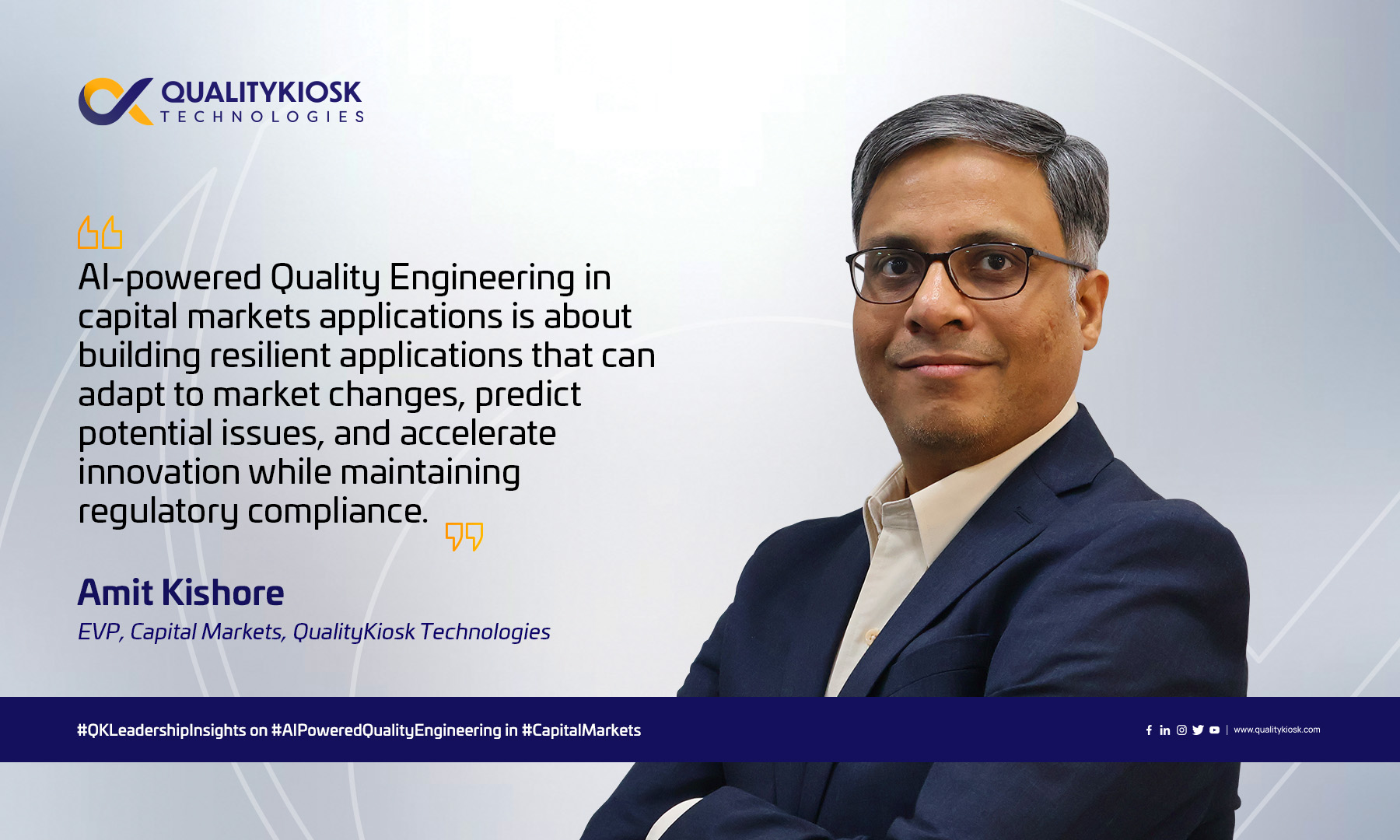In the world of capital markets, where every millisecond can mean millions, the reliability, performance, security, and uptime of trading applications are critical. With the trading applications’ ecosystem expanding and regulations evolving at breakneck speed, financial institutions are under increasing pressure to ensure these key performance indicators (KPIs) are optimized. As financial markets rush to adapt to technological disruptions to meet customer demands, delivering consistent application quality becomes a significant challenge.
AI-powered test automation provides an effective solution for financial markets to address the fast-changing regulatory and customer demands. With its integration into the Software Development Life Cycle (SDLC), AI-powered testing automation can revolutionize Quality Engineering (QE) for accelerated innovation and reduced risks.
Foundations to Enabling AI-Powered Testing Automation in Capital Markets
Before implementing AI-powered testing, organizations need to establish robust foundational elements that enable effective automation. These core components create the infrastructure necessary for AI to function effectively and deliver value.
1. High-Performance Load Testing
A robust infrastructure capable of simulating massive concurrent loads forms the bedrock of any capital markets testing environment. This foundation must support comprehensive performance monitoring, metrics collection, and scalable test execution – essential data points that AI systems will later analyze and optimize.
2. Real-Time Data Integration
A sophisticated data integration framework that can handle market feeds, reference data, and trading scenarios is crucial. This foundation includes data quality checks, synchronization capabilities, and standardized formats that enable AI systems to process and adapt to real-world market conditions.
3. Standardized Multi-Platform Architecture
A unified testing architecture that standardizes how applications are tested across different platforms and environments. This includes consistent test environments, standardized APIs, and normalized data formats that allow AI systems to work seamlessly across diverse platforms without environment-specific customization.
4. Base Security Testing Framework
A comprehensive security testing framework that establishes baseline security checks, compliance requirements, and vulnerability scanning capabilities. This foundation provides the structured security data and testing patterns that AI systems will later enhance and automate.
5. Continuous Integration and Deployment (CI/CD) Integration
Integrating AI-powered test automation with CI/CD pipelines enables continuous testing and rapid deployment of updates to trading platforms. AI optimizes the CI/CD process by identifying the most critical tests to run based on recent code changes, ensuring faster time-to-market and frequent releases without compromising quality.
AI-Powered QE Essentials for Capital Markets
Building upon the established foundations, AI introduces advanced capabilities that transform how quality engineering is performed in capital markets applications.
1. Intelligent Test Case Generation
AI algorithms can analyze application code, user behavior, and historical data to automatically generate comprehensive test cases, ensuring thorough coverage of critical trading scenarios. In capital markets, where applications are highly complex and integrated with various financial instruments, the traditional approach of manually writing test cases is both time-consuming and prone to errors. AI can simulate real-world trading activities, such as order placement, trade execution, and risk management, under different market conditions, ensuring all critical scenarios are tested.
2. Self-Healing Test Scripts
The dynamic environment of trading platforms often involves frequent changes to user interfaces (UIs) and functionalities due to updates or regulatory requirements. Traditional test scripts, which are usually hard-coded, can easily break with even minor UI changes, leading to high maintenance efforts. AI-powered test automation introduces self-healing test scripts that adapt to changes automatically. Machine learning models recognize patterns and intent behind UI elements, allowing test scripts to adjust dynamically to modifications, reducing time and effort required for script maintenance.
3. Predictive Analytics for Test Prioritization
Predictive analytics is a game-changer for test automation in capital markets applications. AI can predict which areas of an application are most likely to fail based on code changes, historical data, and usage patterns, allowing QA teams to prioritize testing efforts effectively. This targeted approach reduces the time spent on testing. It ensures that the most critical and risk-prone areas are tested thoroughly, minimizing the chances of a major failure in production.
4. Visual AI for UI Testing
Maintaining a consistent and error-free UI across different devices and browsers is essential for trading platforms. Visual AI uses advanced image recognition algorithms to detect subtle visual discrepancies that may not be easily noticeable to human testers. By comparing screenshots of the UI from different environments, Visual AI can identify differences in color, alignment, font, and layout, ensuring a uniform and seamless experience across devices and operating systems.
5. Natural Language Processing (NLP) for Regulatory Compliance
AI-powered test automation with Natural Language Processing (NLP) capabilities can streamline compliance processes by analyzing regulatory documents and automatically generating compliance-related test cases. For example, NLP can parse complex regulatory texts, such as MiFID II or Dodd-Frank, and identify relevant clauses that need to be tested for compliance. This reduces the manual effort involved in maintaining compliance and minimizes the risk of regulatory breaches and associated penalties.
6. Intelligent Chaos Engineering
AI enhances traditional chaos engineering by intelligently identifying and injecting the most relevant failure scenarios based on historical incidents and market patterns. The system learns from each chaos experiment to create increasingly sophisticated disaster scenarios, helping build more resilient trading platforms. For example, it can simulate complex combinations of market data feed disruptions and network latency that historically led to trading issues.
7. Smart Security Testing and Automated Remediation
This comprehensive approach delivers the agility to adapt to market changes, the intelligence to predict and prevent issues, and the automation to accelerate innovation. Financial institutions that embrace this transformation position themselves to not just meet today’s challenges, but to thrive in tomorrow’s increasingly complex trading environment.





